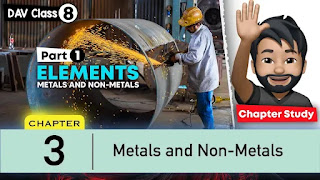All the available study materials for this chapter are listed below. Watch, download, and start studying!
Watch All Videos of This CHapter from PLAYLIST
A. Fill in the Blanks
1. The property, due to which a metal piece can be hammered into thin sheets, is known as mallebility.
2. Bronze is an alloy of copper and tin.
3. Gold is mixed with silver and/or copper to make it hard.
4. Iodine is the only non-metal to have a natural lustre.
5. Phosphorus is a non-metal which catches fire in air.
6. The only metal, which exists in the liquid state at room temperatures, is mercury.
B. Match the Following
1. Hardest substance – (d) diamond
2. Aluminium ore – (c) bauxite
3. A non-metal, normally, existing in the liquid state – (a) bromine
4. A good electrical conductor – (b) graphite
5. A metalloid – (e) arsenic
2. Aluminium ore – (c) bauxite
3. A non-metal, normally, existing in the liquid state – (a) bromine
4. A good electrical conductor – (b) graphite
5. A metalloid – (e) arsenic
C. Tick (✓) the correct option
1. The two most abundant metals, found in the earth’s crust, are -
A) silver and copper
B) iron and zinc
C) tin and lead
D) aluminium and iron
2. The metals, used in making the alloy ‘german silver’, are -
A) copper + tin + aluminium
B) zinc + lead + nickel
C) copper + zinc + nickel
D) iron + zinc + tin
3. When a metal reacts with oxygen, the resulting oxide of the metal -
A) is an acidic oxide
B) is a basic oxide
C) is a neutral oxide
D) forms salt directly
4. Out of the metals, gold, silver, copper and aluminium, the one that is most ductile is -
A) copper
B) gold
C) aluminium
D) silver
5. Two of the metals, that cannot be stored either in air or under water, are -
A) iron and zinc
B) calcium and magnesium
C) lithium and barium
D) potassium and sodium
D. Answer the following questions in brief
1. Name (i) one metal and (ii) one non-metal which normally exists in the liquid state.
Answer:
(i) Mercury is a metal that exists in liquid form at room temperature.
(ii) Bromine is a non-metal that also exists in liquid form at room temperature.
2. State the fraction of gold present in an 18-carat gold piece.
Answer:
Pure gold is 24 carats. So, 18-carat gold means it has 18 parts of gold out of 24.
The fraction of gold is: 18/24 = 3/4
3. State the property of copper wires that makes them useful for electrical fittings.
Answer:
Copper wires are used in electrical fittings because:
Copper is a good conductor of electricity.
It is ductile (can be stretched into thin wires).
It is malleable (can be shaped easily).
It is also affordable.
4. Define an alloy.
Answer:
An alloy is a **mixture of two or more metals, or a metal and a non-metal, combined to improve strength or other properties.
5. List any two uses of non-metals.
Answer:
Phosphorus is used in making matchsticks and fertilizers.
Iodine is used as an antiseptic to clean wounds.
E. Answer the following questions
1. Write the balanced chemical equations for the following reactions:
Answer:
(a) When sodium reacts with oxygen, it forms sodium oxide. The balanced chemical equation is:
4Na + O2 → 2Na2O
(b) When aluminium reacts with dilute hydrochloric acid, it forms aluminium chloride and hydrogen gas. The balanced chemical equation is:
2Al + 6HCl → 2AlCl3 + 3H2
2. Why are gold and platinum suitable for making jewellery?
Answer:
Gold and platinum are good choices for making jewellery because they are soft and can be easily shaped into thin wires or sheets. They also stay shiny for a very long time and do not get dull or rust easily. These metals do not react much with air, water, or other substances, so they last longer. Their attractive appearance and long-lasting quality make them perfect for ornaments.
3. Sodium and potassium are stored under kerosene. Give reason.
Answer:
Sodium and potassium are very reactive metals. They can react quickly with air and water, even at room temperature. If exposed to air or moisture, they can catch fire and cause danger. To keep them safe, these metals are stored under kerosene or paraffin oil. The oil layer prevents contact with air and water, reducing the risk of fire or explosion.
4. Why is bronze preferred over copper metal for making statues?
Answer:
Bronze is a better material than pure copper for making statues. It is an alloy made by mixing copper and tin, and it becomes stronger and harder than pure copper. Bronze does not rust or corrode easily, so statues made from it stay in good condition for a longer time. Its strength and resistance to damage make bronze a good choice for creating durable and beautiful statues.

